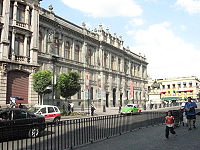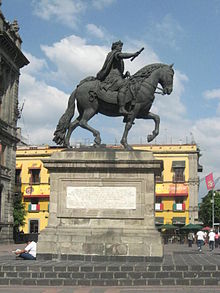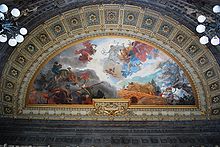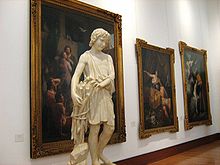- Museo Nacional de Arte
-
Museo Nacional de Arte
Museo Nacional de ArteLocation Historical center of Mexico City Website www.munal.com.mx The Museo Nacional de Arte (MUNAL) (English: National Museum of Art) is the Mexican national art museum, located in the historical center of Mexico City. The museum is housed in a neoclassical building at No. 8 Tacuba, Col. Centro, Mexico City. It includes a large collection representing the history of Mexican art from the mid-sixteenth century to the mid 20th century. It is recognizable by Manuel Tolsá's large equestrian statue of Charles IV of Spain, who was the monarch just before Mexico gained its independence. It was originally in the Zocalo but it was moved to several locations, not out of deference to the king but rather to conserve a piece of art, according to the plaque at the base.[1] It arrived at its present location in 1979.
Contents
The institution
The museum was founded in 1982 as the Museo Nacional de Arte, and re-inaugurated in 2000, after reopening its doors to the public as MUNAL after intense remodeling and technical upgrades to the facility. It currently focuses on the exhibition, study and diffusion of Mexican and international art from the 16th century to the first half of the 20th century. Its permanent collection contains more than 3,000 pieces and has 5,500m2 of exhibition space. MUNAL is a subdivision of the Instituto Nacional de Bellas Artes and as part of this organization is involved in projects concerning the conservation, exhibition, and study of the fine arts of Mexico. The museum also offers workshops, colloquiums, publication and other outreaches to the public. There are also volunteer opportunities such as the Voluntariado and the Amigos de MUNAL associations.[2]
The Palace of Communications building
MUNAL is located in the old Palace of Communications. In the early part of the 20th century, the government hired Italian architect Silvio Contri to design and build this “palace” to house the Secretariat of Communications and Public Works, with the intention to show Mexico's commitment to modernization. The Palace was constructed on the former site of the hospitals of San Andres and of Gonzalez Echeverria. The architectural design is eclectic, mixing elements of past architectural styles, which is characteristic of that time period. This blending would later solidify into a movement called “modernismo” both because of the tendency to use newly-devised construction techniques and the tendency to use metal in the decorative aspects, to symbolize progress in the Industrial Age. The decorative elements of the building were done by the Coppedé family of Florence, who designed the door knockers, the window frames, the leaded crystal, the stonework, the furniture, lamps and ironwork among many other elements. Over the years, much of the Palace deteriorated until around 2000, when Project MUNAL restored the palace to its original look while added the latest technology for the preservation of artistic works.[3]
Two rooms that stand out are the decoration of the Reception Hall and the sculptures in the Patio de los Leones.[3] The Reception Hall is on the second floor and designed to imitate the splendor of similar halls in Europe. It is profusely decorated with precious metal and crystal ornaments as well as allegorical murals dedicated to themes such as science, the arts, liberty, history, work and progress. The work devoted to the concept of progress subdivides into four themes of force, justice, wisdom and wealth. This hall became the preferred place for President Porfirio Diaz to perform public declarations and receive dignitaries from abroad.[4] Like the rest of the building the Patio of the Liones synthesizes a number of different architectural styles. The two primary styles seen here are Classic and Gothic with other styles introduced in the forms of sculptures, lighting and sculpted stonework. In the center is a large semicircular staircase to the upper floors.[5]
Later in the 20th century, the building served as the Archivo General de la Nación and from 1982 as the Museo Nacional de Arte. The plaza in front of the building is named after Manuel Tolsá, who created the statue of Carlos IV there, also known as El Caballito.[3] Today almost all of the building is used to house the permanent collection of MUNAL with the Reception Hall and the Patio de los Leones used for events such as concerts, book-signings and press conferences.[4][5]
The collection
The museum’s permanent collection is designed to give a panoramic view of the development of the fine arts in Mexico from the early colonial period to the mid-twentieth century. The artwork is subdivided into three distinct periods. The first covered the colonial period from 1550 to 1821. The second covers the first century after Independence and the third covers the period after the Mexican Revolution to the 1950s.[6] Works created after that time period are on display at a number of museums, including the Museum of Modern Art in Chapultepec Park.[7] The collection of art from the colonial period is entitled “Asimilación de occidente” (Assimilation of the West) and are contained within Salons 1-14 on the second floor. This collection shows how western-style painting transferred over and synthesized in Mexico, eventually leading to the establishment of Mexico’s own fine arts institution, the Academy of San Carlos, the first of its kind in the Americas. Art from the first century of Mexican Independence (1810–1910) is entitled “La construcción de la Nación” (Construction of a Nation) housed in Salons 19-26 of the second floor. Coinciding with the Romanticism period, most paintings have themes such as Mexican customs and landscapes with the purpose of defining a Mexican identity. The last time period is titled “Estrategías plásticas para un México moderno” (Strategies for the fine arts in modern Mexico) and house in Salons 27-33 on the first floor. Historically, this period is after the end of the Mexican Revolution when questions of modernity and nationalism were foremost. It also coincides with the development of the Mexican muralist movement.[6][8]
Some of the salons are devoted to temporary exhibitions, such as the paintings of Pedro Gualdi from the 19th century,[9] and more contemporary photography exhibitions by Carlos Monsivais and Marina Yampolsky.[10] One of the latest exhibitions was called “The Practice of Everyday Life” which occurred in 2009.[11]
References
- ^ Noble, John (2000). Lonely Planet Mexico City. Oakland California: Lonely Planet. pp. 115. ISBN 1 86450 087 5.
- ^ "MUNAL" (in Spanish). http://www.munal.com.mx/esp/munal/munal.html. Retrieved 10 August 2009.
- ^ a b c "Historia del Antiguo Palacio de Comunicaciones" (in Spanish). http://www.munal.com.mx/esp/palacio/palhis.htm. Retrieved 10 August 2009.
- ^ a b "Salon de Recepciones" (in Spanish). http://www.munal.com.mx/esp/palacio/salon.htm. Retrieved 10 August 2009.
- ^ a b "El Patio de Leones" (in Spanish). http://www.munal.com.mx/esp/palacio/patio.htm. Retrieved 10 August 2009.
- ^ a b "El recorrido Historico Artistico" (in Spanish). http://www.munal.com.mx/esp/colecciones/rha.htm. Retrieved 10 August 2009.
- ^ Gomez, Edgard M (February 2007). "Mexico City’s Moment". Art and Anticues 30 (2): 104–105. ISSN 01958208.
- ^ "El Las colecciones" (in Spanish). http://www.munal.com.mx/esp/colecciones/colecciones.html. Retrieved 10 August 2009.
- ^ Tibol, Raquel (June 1997). "Pietro Gualdi. (Museo Nacional de Arte,México, D.F., México)" (in Spanish). Proceso.
- ^ "Ciclo de Primavera en el Munal: Heroes y Valentones. (Living in Mexico).(photography exhibition, Museu Nacional de Arte, Mexico City)(Brief Article)" (in Spanish). Business Mexico. 2001.
- ^ Monsalve, Federico (May 2009). "The Practice of Everyday Life". ARTnews 108 (5): 125–125. ISSN 00043273.
External links
Landmarks and historic buildings of Mexico City Centro Zócalo
and immediate vicinitySchools and colleges Universidad del Claustro de Sor Juana · Academia Mexicana de la Historia · Academy of San Carlos · Colegio de San Ignacio de Loyola Vizcaínas · Antigua Escuela de Economía · Colegio Nacional · Colegio de Minería
Government buildings Old Customs Building · Chamber of Deputies · Departamento de Estadistica Nacional · Secretariat of Public Education Main Headquarters · Senate building · Supreme Court building · Palace of the Marqués del Apartado · Library of the Congress of Mexico
Religious buildings Nuestra Señora de Loreto Church · Church of San Francisco · Church of Nuestra Señora de Valvanera · Church of San Bernardo · Ex Temple of Corpus Christi · La Enseñanza Church · La Merced Cloister · La Santisima Church · Temple and Ex-convent of Jesus Maria · Church of San Juan de Dios · Santa VeraCruz Church · Regina Coeli Church · Santa Teresa la Antigua · Temple of San Pablo el Nuevo · Church of Santo Domingo · Temple of Saint Augustine · Temple of San Felipe Neri "La Profesa" · Church of La Soledad
Museums San Ildefonso College · Caricature Museum · Franz Mayer Museum · Museum of the City of Mexico · Interactive Museum of Economics · Museo de Arte Popular · José Luis Cuevas Museum · Palace of the Inquisition (Museum of Mexican Medicine) · Mexican Army Museum · Museo Nacional de Arte · Museo de Charrería · Museo de la Estampa · Museo de Estanquillo · Museum Archive of Photography · Museum of Secretaría de Hacienda y Crédito Público · San Pedro y San Pablo College (Museum of Light) · House of the First Print Shop in the Americas · National Museum of Cultures · Borda House, Mexico City
Palaces Castillo de Chapultepec · Palace of Iturbide · Palacio de Bellas Artes · Palacio de Correos de Mexico · Casa de los Azulejos · Houses of the Mayorazgo de Guerrero · Palace of the Marqués del Apartado · Palacio de la Autónomia
Historic houses Tlaxcala House · House of Count de la Torre de Cossio · House of the Marquis of Uluapa · House of the Count de la Torre Cosío y la Cortina
Other Plaza Garibaldi · Antigua Escuela de Jurisprudencia · Chinatown (Barrio Chino) · Tlaxcala House · Garden of the Triple Alliance · Centro Cultural de España (Mexico City) · INAH Building · Abelardo L. Rodriguez Market · La Merced Market · Lirico Theatre · Alameda Park · Plaza Santo Domingo · Teatro Hidalgo · Teatro de la Ciudad · Torre Latinoamericana · Hospital de Jesús Nazareno · Tlaxcoaque
Categories:- Art museums and galleries in Mexico
- National museums of Mexico
- Museums in Mexico City
- Buildings and structures in Mexico City
- Landmarks in Mexico City
- History of Mexico
- 18th century in Mexico
- Mexican architecture
- Colonial Mexico
- Neoclassical architecture
- Mexican art
Wikimedia Foundation. 2010.





